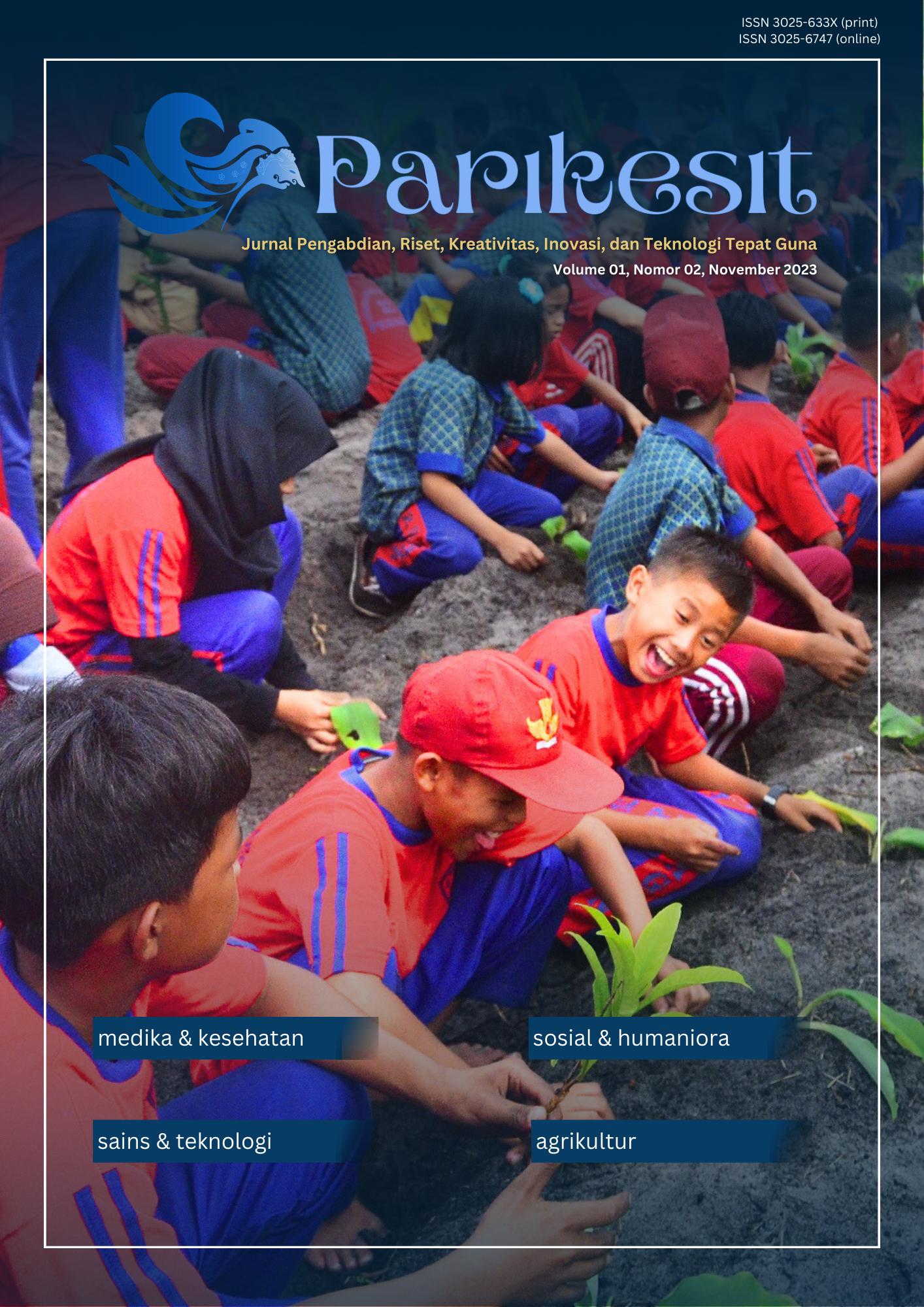Analisis Penyebab Penyebaran Eceng Gondok (Eichornia crassipes) di Daerah Pesisir Pantai, Desa Tempel, Demak, Jawa Tengah beserta Alternatif Solusinya
Abstrak
Desa Tempel yang terletak di Kabupaten Demak, Jawa Tengah menjadi salah satu contoh desa yang perairannya mengalami eutrofikasi atau pengkayaan badan air dari mineral dan nutrien yaitu ditandai dengan tumbuhnya gulma eceng gondok yang tidak terkendali. Hal ini disebabkan karena adanya kiriman dari aliran sungai daerah di atasnya yang ditambahkan dengan nutrisi berlebih dari areal persawahan. Salah satu penanganan eutrofikasi yaitu dengan cara mengurangi penggunaan pupuk anorganik atau mengganti dengan pupuk organik. Pelaksanaan program penyuluhan masyarakat ini bertujuan untuk meningkatkan kesadaran masyarakat terhadap keberadaan gulma eceng gondok yang berdampak negatif bagi ekosistem beserta solusinya. Metode pelaksanaan kegiatan meliputi observasi lapangan yang dilanjutkan dengan sosialisasi dan pelatihan dengan pihak terkait. Sosialisasi dilakukan untuk memberikan informasi mengenai penyebab adanya eceng gondok akibat eutrofikasi yang berhubungan dengan permasalahan pertanian. Kegiatan dilanjutkan dengan program Kali Bersih untuk mengurangi biomassa eceng gondok. Pelatihan meliputi pembuatan kompos dan pupuk organik cair serta biobriket dari eceng gondok. Hasil diskusi terakhir mengenai keberlanjutan program kerja diketahui bahwa pemahaman masyarakat tentang permasalahan eceng gondok mengalami peningkatan dari hasil diskusi awal sebelum diadakannya serangkaian kegiatan penyuluhan ini. Program penyuluhan masyarakat ini diharapkan dapat meningkatkan pengetahuan masyarakat Desa Tempel dalam memahami dampak negatif keberadaan eceng gondok sebagai gulma dan penanganannya untuk keseimbangan ekosistem serta pencegahan terjadinya bencana banjir.
Referensi
Ahzan, S., Pangga, D., Prasetya, D. S. B., & Wijaya, A. H. P. (2021). Pengembangan Briket Berbahan Dasar Eceng Gondok dan Abu Sekam Padi sebagai Alternatif Bahan Bakar Oven Tembakau. Jurnal Hasil Kajian, Inovasi, dan Aplikasi Pendidikan Fisika, 7(1), 98-102.
Alfionita ANA, Patang, Kaseng ES. 2019. Pengaruh Eutrofikasi terhadap Kualitas Air di Sungai Jeneberang. Jurnal Pendidikan Teknologi Pertanian, 5(1): 9-23.
Ashlihah, Saputri, M.M., & A. Fauzan. (2020). Pelatihan Pemanfaatan Limbah Rumah Tangga Organik menjadi Pupuk Kompos. Jurnal Pengabdian Masyarakat Bidang Pertanian, 1(1): 30-33.
Fatimah, N., Sugiarti, & Sudding. (2022). Perbandingan Karakteristik Briket Tempurung Kelapa yang Menggunakan Perekat Kanji dan Perekat Sagu. Jurnal Chemica, 23(1), 30-42.
Hasibuan, R., & Pardede, H. M. (2023). Pengaruh Suhu dan Waktu Pirolisis terhadap Karakteristik Arang dari Tempurung Kelapa. Jurnal Teknik Kimia USU, 12(1), 46-53.
Herlina, Ghitarina, & Eryati, R. (2019). Kandungan PB, CD, dan CU pada Eceng Gondok (Eichornia Crassipes) pada Perairan Sungai Karang Mumus Samarinda Kalimantan Timur. Jurnal Aquarine, 6(2), 1-6.
Manalu, K & Rasyidah. (2021). Pelatihan pemanfaatan eceng gondok sebagai pupuk kompos bagi masyarakat Desa Jentera Kecamatan Wampu Kabupaten Langkat. Jurnal Pengabdian Kepada Masyarakat, 27(4), 393-399.
Mubarok, L. R., & Suprayogi, S. (2018). Kajian Karakteristik Pencemar Bagian Hulu Sungai Belik, Daerah Istimewa Yogyakarta. Jurnal Bumi Indonesia, 7(2).
Nugrahini, A. D., Ainuri, M., Wagiman, Amalia, R., & Hasanati, S. 2023. Community empowerment in transforming household and agricultural waste into valuable products towards the green village concept. Indonesian Journal of Community Engagement, 9(2), 76-82.
Rahmiyanti, S., Maru, R., Mangngesak, N. L., Mutmainnah, A. N., & Handayani, R. (2022). Pemanfaatan Tanaman Eceng Gondok menjadi Kerajinan Anyaman sebagai Upaya dalam Mengurangi Pencemaran Sungai di Kecamatan Pammana. Panrita Inovasi: Jurnal Pengabdian Kepada Masyarakat, 1(1), 17-23.
Tanti, N., Nurjannah, & Kalla, R. (2019). Penggunaan pupuk organik cair dengan cara aerob. ILTEK, 14(2), 2053-2058. BKKBN. (2011). Profil Hasil Pendataan Keluarga Tahun 2011. Jakarta: Badan Kependudukan dan Keluarga Berencana Nasional.
Copyright (c) 2023 Jurnal Pengabdian, Riset, Kreativitas, Inovasi, dan Teknologi Tepat Guna

This work is licensed under a Creative Commons Attribution-ShareAlike 4.0 International License.









